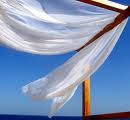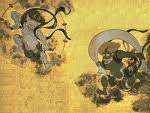::::::::::::::::::::::::::::::::::::::::::::::::::::::::::::::::::::::::::::::::::::::::::::::::::::
Wind in summer
***** Location: Japan
***** Season: Summer
***** Category: Heaven
*****************************
Explanation
Please read the basics about WIND here:
. Wind in various kigo (kaze)

There are many regional winds along the shore of Japan, whith different names.
:::::::::::::::::::::::::::::::::::::::::::::::::::::::::::::::::::::::::::::::::::::::::::::::::::::
summer wind (natsukaze 夏風)
south wind (nanpuu, minami 南風 hae はえ)
..... White southern wind(shirahae) 白南風 (しらはえ)
hae gochi, haegochi 南東風(はえごち)south-east wind
hae nishi, haenishi 南西風(はえにし)south-west wind
cool breeze, refreshing breeze (ryoofuu, suzukaze 涼風)
late summer, see below
fragrant breeze, balmy breeze, scented breeze (kunpuu 薫風、kaze kaoru 風薫)
this is best not translated as, for example, scented WIND.
breeze on green rice paddies (aota kaze 青田風)
The breeze that wafts across the field is called aota kaze (青田風[あおたかぜ]); the wave of paddy created by the wind is aota nami (青田波 [あおたなみ]); the time is aota doki (青田時[あおたどき]); and the path that cuts across the field is aota michi (青田道[あおたみち]).
breeze of a waterfall (takikaze 滝風)
wind on young leaves (wakabakaze 若葉風)
summer storm, "Green Tempest" (natsu arashi 夏嵐,ao-arashi 青嵐)
seiran 青嵐(せいらん) "green storm"
thunderstorm, "thunder and rain" (raiu, rai-u 雷雨)
The etymology is traced to the native Japanese word "the roar of the gods" (神鳴 [かみなり] kaminari). The Chinese character "god"(神 [かみ] kami)signified both thunder and thunder god.

Gods of Wind and Thunder 風神雷神
koojakufuu 黄雀風 (こうじゃくふう) "yellow sparrow wind"
south-easterly wind in the fifth lunar month
When this wind blows,the fish in the deep sea turn to little sparrows, as Chinese legend tells us.
Südostwindim fünften Mond-Monat
maji まじ humid southern wind
..... maze まぜ
Especially at the Izu peninsula and the Inland sea and other regions along the Pacific.
..... kudari くだり "coming down" southern wind along the Sea of Japan and Northern Japan
In former times, the region of things coming down from Kyoto was called "kudari".
Wind in the opposite direction is "nobori".
hikata ひかた
"wind blowing in the direction of the sun"
.....shikata しかた
An expression used mostly in San-In, Western Japan and Kyushu.
ai no kaze, ainokaze あいの風 (あいのかぜ)
"northern wind"
..... ae no kaze あえの風(あえのかぜ)
An expression used mostly along the Sea of Japan and San-In, Western Japan, when the wind hits the coast directly.
dashi だし summer wind in the Echigo area
nanuka dashi 七日だし(なぬかだし)dashi blowing for seven days
dashigumo だし雲(だしぐも) clouds predicting a dashi
This wind comes over the sea and blows over the mountains of Echigo, it is also experienced inland in the farming villages. Wehn the small white clouds come inland over the mountains, it is bound to blow soon.
yamase やませ "wind from the back of the mountain"
..... yamase kaze 山瀬風(やませかぜ)/山背風(やませかぜ)
Cold northern wind, mostly in Hokkaido and Northern Japan, blowing down a mountain. From June till August, related to summer weather patterns in the Sea of Okhotsk.
:::::::::::::::::::::::::::::::::::::::::::::::::::::::::::::::::::::::::::::::::::::::::::::::::::::
kigo for early summer
kinome nagashi 木の芽流し (きのめながし)
"wet southern wind on the tree buds"
takenoko nagashi 竹の子ながし "wet southern wind on the bamboo shoots"
takenokozuyu 筍梅雨(たけのこづゆ)rainy season on the bamboo shoots
..... takenokozuyu 筍黴雨(たけのこづゆ)
tsubana nagashi 茅花流し (つばなながし)
wet southern wind on the red reed grass
Imperata cylindrica
mugi no aki kaze 麦の秋風 (むぎのあきかぜ )
wind on the barley fields
mugi arashi 麦嵐(むぎあらし) storm on the barley fields
.
"barley autumn", mugi no aki 麦の秋 (むぎのあき)
.................................................................................
kigo for mid-summer
inasa いなさ south-easterly wind in the Kanto plains
Usually a very strong wind, almost storm, that needs percautions to be taken like in a typhoon. It is feared by the fishermen along the coast. Because of its direction, it is also called after the heavenly directions "tatsumi" (辰巳 ).
inasamaze, inasamono, inagochi are other names.
.................................................................................
kurohae, kuro-hae 黒南風 (くろはえ)
"black southern wind"
..... kurobae くろばえ
arahae, ara-hae 荒南風(あらはえ)"wild southern wind"
HAE is an expression for a southernly wind, since the southern direction used to be called HAE in some areas of Japan.
When this southern wind starts to blow, the rainy season is about to start. In the middle of the rainy season, this wind gets stronger, to a "wild" wind.

Basho Statue at river Sumidagawa, Tokyo
黒南風や大河に臨む芭蕉像
kuro-hae ya taiga ni nozomu Bashoo zoo
black southern wind -
the statue of Basho faces
the big river
Suda Shuichi 須田修一
.................................................................................
kigo for late summer
nagi 凪
is an expression for a time without any wind, a calm, a lull.
asanagi 朝凪 (あさなぎ) calm in the morning
..... asa nagu 朝凪ぐ(あさなぐ)
yuunagi 夕凪 ゆうなぎ calm in the evening
yuunagu 夕凪ぐ(ゆうなぐ)
夕凪や島の民話の皆哀し
yuunagi ya shima no minwa no mina kanashi
calm in the evening -
the folktales of this island
are all so sad
Mitsuda Mariko 密田真理子
.................................................................................
shirohae, shiro-hae 白南風 (しろはえ)
"white southern wind"
..... shirobae しろばえ、shirahae しらはえ
When the rainy season has finally moved past the most northern parts of Japan, the sky begins to clear and the dry wind brings white clouds. Its naming is in contrast with the overdast days of the "black southern wind".
It is amazing to see the fine observances of the wind in olden times, from BLACK to WILD to WHITE.

白南風や乾びきつたる捕鯨基地
shira-hae ya karabikitaru hokeikichi
white southern wind -
the whalefisher's basecamp
is dying out
Kasahara Satoshi 笠原さとし
There were many basecamps during the fishing season.
.................................................................................
nagashi ながし "floating weat wind"
nagashihae, nagashi-hae ながし南風(ながしはえ)
Another expression for the wind during the rainy season, especially in Kyushu (where is is used as a synonym for the "rainy season".
doyooai, doyoo ai 土用あい (どようあい)
wind during the dog days
A cool northern wind during the hottest time of summer.
This is an expression of the fishermen from the Kinki and Western Japan, when the cool wind, reminding them of autumn already, hits the coast directly.
doyoo gochi 土用東風 (どようごち) eastern wind during the dog days
aogochi, ao-gochi 青東風(あおごち) "green eastern wind"
doyoo nagi 土用凪 (どようなぎ ) lull, calm during the dog days
no wind at all, Windstille, Flaute
. Dog Days (doyoo)
neppuu 熱風 (ねっぷう) hot wind
enpuu 炎風(えんぷう)"flaming hot wind"
kanpuu 乾風(かんぷう)dry wind
A hot dry wind, blowing on the side of the Sea of Japan, almost like a foehn フェーン , which usually blows in > spring.
onpuu 温風 (おんぷう) warm wind
shippuu 湿風(しっぷう) wet wind
Usually wet, resulting from weather patterns on the Southern Pacific ocean.
ryoofuu 涼風 (りょうふう)
cool breeze, refreshing breeze
..... suzukaze 涼風
kaze suzushii 風涼し(かぜすずし) wind feels cool
Even the slightest breeze is welcome during the hot, humid summer in Japan.
.................................................................................
wind is dying, kaze shisu 風死す
when the wind is dying down in the early afternoon on a hot summer day and you feel the heat especially hot.
風暴れやがて風死す漁村かな
kaze abare yagate kaze shisu ya gyoson kana
stormy wind
changing to dying wind -
a fishing village
http://www.nhk.or.jp/haiku/html/haiku15-6-14.htm
風死すや能登塩田の筋目引く
kaze shisu ya Noto enden no sujime hiku
wind dying down -
drawing straight lines in
the salt fields of Noto
www.acc-n.com/haikutaikai3.htm
Tr. Gabi Greve
The Salt Fields of Japan
:::::::::::::::::::::::::::::::::::::::::::::::::::::::::::::::::::::::::::::::::::::::::::::::::::::
.. .. .. wind in other summer kigo
airing out (kaze-ire 風入)
. ventilator, electrical fan (senpuuki 扇風機)
Wind Chimes (fuurin 風鈴)
Canterbury bells, lit. Wind Chime Flowers (fuurinsoo 風鈴草)
Campanula medium
:::::::::::::::::::::::::::::::::::::::::::::::::::::::::::::::::::::::::::::::::::::::::::::::::::::
*****************************
Worldwide use
Monsoon
..(India, South Asia)
is also connected with the seasonal changes of the wind.
.................................................................................
Germany
Sommerwind
.................................................................................
South Africa
"Cape Doctor" (usually The Cape Doctor or "die Kaapse dokter" in Afrikaans) is the local name for the strong, persistent and dry south-easterly wind that blows on the South African coast from spring to late summer (September to March in the southern hemisphere).
It is known as the Cape Doctor because it has long been held to clear Cape Town of pollution and 'pestilence'.
© More in the WIKIPEDIA !

*****************************
Things found on the way
*****************************
HAIKU


natsu . . . . . kaze
*****************************
Related words
BACK TO
WIND in various seasons
:::::::::::::::::::::::::::::::::::::::::::::::::::::::::::::::::::::::::::::::::::::::::::::::::::






9 comments:
So interesting... Thank you very much!
aota 青田 green fields
haiku by
Matsuo Basho
http://haikutopics.blogspot.jp/2006/05/green-midori-ao.html
Matsuo Basho
風薫る羽織は襟もつくろはず
風かほるはをりはゑりもつくろはす
kaze kaoru haori wa eri mo tsukurowazu
Yosa Buson
薫風やもよぎ匂ひの鎧ぬぐ
kunpuu ya moyogi nioi no yoroi nugu
fragrant breeze -
I take off my armour
smelling of leek
MORE about yoroi - armor
. south wind (nanpuu, minami 南風) .
尼も乗る松前船の南風かな
ama mo noru kitamaebune no minami kana
South Wind
for the Matsumae Sailboat
with a nun on board . . .
. 飯田蛇笏 Iida Dakotsu .
.
MORE about the kitamaebune
.
summer breeze . . .
納涼の河童二匹で語ること
nooryoo no kappa nihiki de kataru koto
two Kappa
talking in the cool
of the summer breeze . . .
鴻風 Kofu
- - - - -
川内の河童は見えず寝込む夏
Sendai no kappa wa miezu nekomu natsu
to bed early in summer
not even seeing
the Kappa at Sendai
チー Chii
- - - - -
河童など出そうな譚や風薫る
kappa nado desoo na tanshi ya kaze kaoru
seems like a poem
about kappa is coming up now -
fragrant summer breeze
鴻風 Kofu
.
MORE haiku about the kappa water goblin
.
まほろばの吉備津の神の青嵐
mahoroba no Kibitsu no kami no ao arashi
a summer storm
for the gods of Kibitsu,
the land of bliss
Kurata Koobun 倉田紘文 Kurata Kobun (1940 - 2014)
.
more about mahoroba
http://kappapedia.blogspot.jp/2015/03/mahoroba.html
.
薫風や鼻緒のゆるき有楽苑
kunpuu ya hanao no yuruki yuurakuen
this fragrant breeze -
the loose string of my sandal
at Yuraku-En
Satoo Mieko 佐藤美恵子 Sato Mieko
More about Oda Urakusai Nagamasu 織田有楽斎長益
and Yurakucho in Edo
.
http://edoflourishing.blogspot.jp/2016/05/yurakucho-district.html
.
その人の足あとふめば風薫る
sono hito no ashiato fumeba kaze kaoru
there is a fragrant breeze
if you can step on the footprints
of a loved one
. Masaoka Shiki 正岡子規 .
.
The Gofunai Henro Pilgrimage in Edo / Tokyo
https://gokurakuparadies.blogspot.jp/2016/12/gofunai-henro-temples-tokyo.html
.
Post a Comment